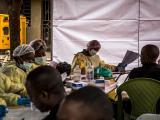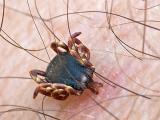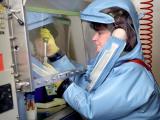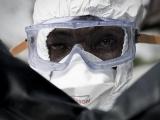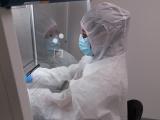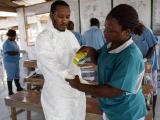A lab technician at the Centers for Disease Control and Prevention (CDC) remained free of symptoms today after possible exposure to Ebola virus from the mishandling of material last week, according to CDC officials.
The CDC reported on Dec 24 that some material from an Ebola experiment that may have contained live virus was mistakenly moved from a biosafety level 4 (BSL-4) lab to a BSL-2 lab, leading to possible exposure of a technician who worked with the material in the less secure lab.
There was no exposure outside the labs involved and no exposure or risk to the public, the CDC said in its Dec 24 statement on the incident. It said the mistake was discovered by the lab personnel on Dec 23 and reported within an hour. A Washington Post report said the misrouting of the sample occurred Dec 22.
The technician has shown no signs of illness, CDC spokeswoman Barbara Reynolds told CIDRAP News today. The unidentified worker will be monitored for 21 days, which is believed to be the maximum incubation period for the virus, officials have said.
The CDC said the BSL‐2 lab area had already been decontaminated and the material destroyed as a routine procedure before the error was identified. The lab was decontaminated for a second time and is now closed, and transfers from the BSL‐4 lab have been stopped while a review of the incident is conducted, the agency said.
Besides conducting an internal investigation of the mishap, the CDC said it reported it to Health and Human Services Secretary Sylvia Burwell and to the internal and external Select Agent Programs. Reynolds said the results of the internal probe should be ready in late January.
She said the incident has not interrupted the CDC's Ebola diagnostic work.
Lapses earlier this year
The mistake puts CDC lab safety in the spotlight once again, following lapses earlier this year. In June, scores of lab workers were potentially exposed to Bacillus anthracis, the cause of anthrax, when technicians didn't properly inactivate samples before sending them to other labs. In July the agency revealed that a sample of low-pathogenicity H9N2 avian influenza virus the CDC sent to a US Department of Agriculture lab had been contaminated with the highly pathogenic H5N1 virus.
Neither of those incidents led to human or animal illnesses or outbreaks.
Commenting on the Ebola mishap, CDC Director Tom Frieden, MD, MPH, said, "I am troubled by this incident in our Ebola research laboratory in Atlanta. We are monitoring the health of one technician who could possibly have been exposed and I have directed that there be a full review of every aspect of the incident and that CDC take all necessary measures.
"Thousands of laboratory scientists in more than 150 labs throughout CDC have taken extraordinary steps in recent months to improve safety. No risk to staff is acceptable, and our efforts to improve lab safety are essential—the safety of our employees is our highest priority."
According to the Post's Dec 24 story, the technician in BSL-2 lab who handled the material from the BSL-4 lab should have recognized from the color coding on the test tubes that it was hazardous and was not meant to be moved from the more secure lab.
In response to the mishaps earlier this year, the CDC announced a number of steps to improve lab safety, including setting up an external advisory group on lab safety and an internal review group to examine the causes of the problems.
Safety improvement efforts
Today Reynolds listed a number of steps that are either completed or under way, one of which is to establish "an agency-wide lead position for laboratory science and safety." The agency is currently working to recruit this person, who "will be empowered to identify problems, establish plans to solve them, and hold programs throughout CDC accountable for follow-up."
Other steps that Reynolds noted include:
- Requiring that validated methods be used to inactivate dangerous pathogens
- Requiring verification of sterility for any materials sent out of the CDC
- Launching a network of 1,600 CDC lab scientists for better collaboration and coordination across the agency; the network has already been used to collect input and distribute timely information on lab safety
In July the CDC announced the names of an 11-member external group to advise top CDC officials on lab safety issues. Kenneth Berns, PhD, an emeritus professor at the University of Florida, was named chair of the group.
Reynolds said future plans include setting up extensive competitive training programs similar to the Epidemic Intelligence Service and initiating external audits and certification of all labs.
See also:
Dec 24 CDC statement
Dec 24 Washington Post story
Related Jul 11 CIDRAP News story
Related Jul 24 CIDRAP News item



